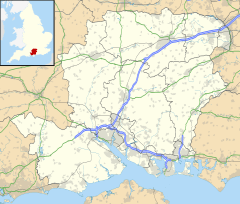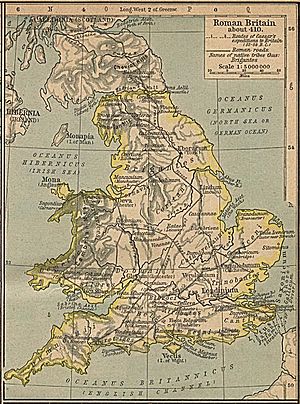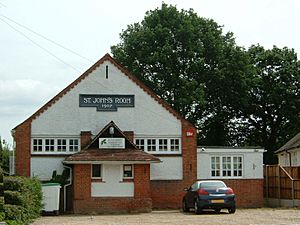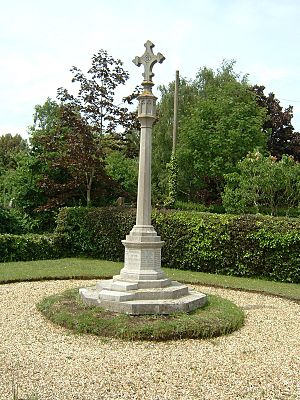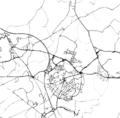Hedge End facts for kids
Quick facts for kids Hedge End |
|
|---|---|
 The town centre |
|
| Population | 20,790 (2011 Census) |
| OS grid reference | SU490128 |
| Civil parish |
|
| District |
|
| Shire county | |
| Region | |
| Country | England |
| Sovereign state | United Kingdom |
| Post town | SOUTHAMPTON |
| Postcode district | SO30 |
| Dialling code | 01489 |
| Police | Hampshire |
| Fire | Hampshire |
| Ambulance | South Central |
| EU Parliament | South East England |
| UK Parliament |
|
| Website | Hedge End Town Council |
Hedge End is a town and a local government area called a civil parish in Hampshire, England. It is located east of the City of Southampton. Hedge End is next to the areas of West End and Botley. It is part of the Borough of Eastleigh and the larger Southampton Urban Area.
The first small settlement, or hamlet, of Hedge End began on Botley Common after 1250. This land was given to the people of Botley for their animals to graze. In 1267, special permissions from the king allowed Botley to have a yearly fair and a weekly market. This helped the area grow into a market town.
Contents
History of Hedge End
Early Beginnings
Before the Romans arrived, the Belgae tribe lived in the Hedge End area. A Roman road passed through here. This road connected Clausentum (a Roman port near modern Southampton) to Portus Adurni (Portchester Castle) and Noviomagus Reginorum (Chichester).
River crossings at Mansbridge (on the River Itchen) and Botley (on the River Hamble) were built around AD 932. The road connecting these crossings likely followed the path of today's Grange Road. From Mansbridge, it's about 4 miles (6.4 km) to Southampton's port. It's also 12 miles (19 km) to Winchester, which was once England's capital city. Kings of England used to own hunting grounds at King's Copse.
Records from 1219 mention farming at the Manor of Shamblehurst. While this area is now part of Hedge End, the first small settlement of Hedge End started on Botley Common. This land was given to the people of Botley in 1250 for grazing animals. This area was good for settlement because it had many natural streams and springs.
In the past, before a law in 1588, people could build a house on common land if they could put a roof over their heads and light a fire between sunrise and sunset. This rule, along with a good water supply, allowed some homes to be built on Botley Common from 1250 onwards.
In 1267, royal permissions allowed Botley to hold a yearly fair and a weekly market. This helped Botley become a market town. People living on Botley Common found it convenient to be close to this market and the mills at Botley and Bursledon.
The Manor of Shamblehurst stopped existing in the 16th century. Botleigh Grange was built in the 16th century on land that used to be part of this manor.
The name "Hedge End" first appeared in the early 1700s. A court record from 1735 mentions a cottage and garden at Hedge End. A 1759 map of Southampton also shows Hedge End.
Laws called inclosure acts changed how common land was used. This land had to be fenced and officially owned. This led to many farms being set up in the Hedge End area in the late 1700s and 1800s.
Growing into a Village
Two new roads were built to reach toll bridges at Northam and Woolston. These roads made it easier for travelers to get to Hedge End. The Northam road opened in 1799, with a tollgate in Hedge End. In 1839, another new road was built to reach the Floating Bridge at Woolston. This new road went through the middle of Botley Common, allowing more development. Today, this road is St. Johns Road.
A law passed between 1863 and 1865 officially divided Botley Common into plots of land. Some plots were used for building. Two acres (8,100 m²) were set aside for small gardens (allotments). Three acres (12,000 m²) were given to William Warner, the lord of the manor, to be used as a Recreation Ground.
St. John's School was built in 1863. It welcomed its first 13 students on January 18, 1864. By 1885, the school building had been made bigger twice. By 1888, it was also used as a library.
St. John's Church was started in 1873 and officially opened on July 15, 1874. In February 1876, St. John's, Hedge End became its own separate church area.
A small post office opened on August 2, 1894. Hedge End officially became a civil parish on December 14, 1894. In 1895, the parish took over looking after the recreation ground. This recreation ground, between St John's Road and Bursledon Road, is all that remains of Botley Common.
In the late 1800s, Hedge End was known for growing strawberries, like many nearby villages. The strawberries were sent to London and Scotland by train from Botley station.
St. John's Rooms was built in 1907. It was the church hall until the Underhill Centre opened in 2002. The Underhill Centre was named after Reverend Mervyn Spenser Underhill, who was the Vicar of St John's Church from 1961 to 1994. St. John's Rooms is now a day nursery for young children.
Wartime History
During World War II, some people from Southampton moved to Hedge End to avoid air-raids. In 1943 and 1944, before D-Day (the invasion of Europe), Hedge End was on the edge of a large military preparation area in Hampshire. This area was called Area C. The closest military camp, Camp C3, was at Netley Common. Hedge End was part of a smaller section called sub-area Z within Area C.
Military maps from May 1, 1944, show St Johns Road and Upper Northam Road as routes for military vehicles. Upper Northam Road was also used as a vehicle park.
Hedge End was in a "Regulated Area" set up on March 31, 1944. This area had rules about how people could move around in the final preparations for D-Day.
A V-1 flying bomb (a type of German missile) hit HMS Cricket, a military camp just outside Hedge End, on July 15, 1944.
Becoming a Town
The building of the M27 motorway helped Hedge End grow even more in the last 20 years of the 20th century. However, as a suburb of Southampton, it had already started growing quickly in the two decades before the motorway arrived.
Hedge End is located near Junctions 7 and 8 of the motorway. With easy access to this new road, the village expanded rapidly. New office parks, large out-of-town stores, and new housing areas were built.
The newest big development in Hedge End is Grange Park, located north and east of the village center. It has grown a lot over several years and now includes a public park at Dowd's Farm. In the early 1990s, the village got its own Hedge End railway station, opened by British Rail. This station is on the Eastleigh to Fareham line.
In 1992, the local council decided to change the village's status to a town. The council was then renamed Hedge End Town Council.
Hedge End is twinned with Comines-Warneton in Belgium. The twinning agreement was signed in 1994, but not much twinning activity happens now.
On May 21, 2011, Marwell Wildlife was called by the police to help with a white tiger seen in the grass. It turned out to be a life-size cuddly toy!
Community and Culture
Carnival Fun
The first Hedge End Carnival was held in 1921. It aimed to raise money to pay for a nurse, as there were no medical facilities in Hedge End at that time. It is believed that the carnival did not happen every year, especially during the Second World War.
The carnival used to take place every year on the first Saturday of July. The week before the carnival day had many events and entertainment organized by the Hedge End Carnival Committee. These included a quiz night, a scavenger hunt, a dog show, Bingo, history walks, and children's sports day. Other events throughout the year included a Senior Citizens' lunch in October for all pensioners in Hedge End, and a Fireworks Fiesta and Fun Fair in November.
All money raised by the carnival and its events was given to local volunteer and charity groups. The rules of the Hedge End Carnival Committee stated that all money raised must help the people of Hedge End. Sadly, due to a lack of volunteers, the carnival stopped in 2023.
Local Radio Station
From 2006 to 2023, Hedge End had its own non-profit radio station called Skyline Gold on 102.5FM. David Gates founded Skyline. It was first funded by grants, then by advertising from local businesses. Skyline played many types of music, including rock, country, and pop. It also featured interviews with local community groups.
Skyline used to broadcast from studios in the Old School House on St. Johns Road. Hedge End Town Council provided this space for free. In October 2023, the Town Council decided not to support the station anymore. This forced Skyline to move to a building in nearby Botley. All the people who worked at the station were unpaid volunteers. Since February 10, 2007, Skyline has also streamed live on the internet.
Education in Hedge End
Hedge End has several schools for its young residents.
Wildern School is a large school with about 1,800 students. It has a media center called the d.@rt Centre, which stands for "Digital Art." The school also has a recently updated sports center. This center is open to the local community and includes a hall, an indoor heated swimming pool, a toddlers' swimming pool, a gym, and a dance studio. It also has a Multi Use Games Area (MUGA), which is an all-weather sports surface. Deer Park School was built and opened in September 2021.
Shamblehurst Primary School is next to the Wildern School site. Freegrounds Infant and Junior Schools share a site on the other side of the town center. King Copse Primary School is also in Hedge End, near the Cranbourne Park area. Kings Copse Primary School was completely rebuilt and opened in September 2008. Berrywood Primary School and Wellstead Primary School serve the Grange Park area.
Famous People from Hedge End
Several notable people have lived in Hedge End:
- Actor Robin Nedwell, known for TV shows like Shillingbury Tales and Doctor in the House, lived here until his death in 1999.
- Footballer Kevin Moore.
- Geneticist Joseph Smartt.
- Paul Holmes, who is a Member of Parliament for Eastleigh.
- A.F.C Totton footballer Brett Williams.
- Reverend Clement Smith.
Twin Towns
Hedge End is twinned with:
Images for kids
-
OpenStreetMap tracklogs around Hedge End
See also
 In Spanish: Hedge End para niños
In Spanish: Hedge End para niños


